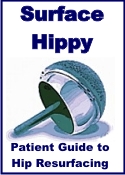TKA performed with porous tantalum tibial component shows good 5-year survivorship
March 2008
SAN FRANCISCO - Total knee arthroplasty performed using a cemented monoblock
porous tantalum tibial component shows high survivorship and radiographic
stability at 5 years follow-up, according to a study presented here.
Thomas J. O'Keefe, MD, and colleagues at St. Joseph Mercy Hospital in Ann Arbor,
Mich., evaluated the 5-year clinical and radiographic outcomes for total knee
arthroplasty (TKA) performed using the Implex CKS knee system with a monoblock
porous tantalum-polyethylene posterior-stabilized tibial component.
They displayed their results in a poster at the American Academy of Orthopaedic
Surgeons 75th Annual Meeting.
"The implant possesses a modulus of elasticity similar to subchondral bone,
which allows for stress transfer, limits proximal stress shielding and obviates
the need for a central stem to protect against offset loads. The monoblock
design eliminates backside wear, thereby decreasing wear-induced particle load,"
the authors said in the study.
"All tibial components were implanted with a cemented horizontal surface and
press-fit pegs," they noted.
Between April 2001 and June 2002, 137 consecutive TKAs were performed using the
device by a single surgeon on 101 patients, primarily for osteoarthritis.
At 5 years, 28 of the 101 patients could not complete follow-up exams. Another
two patients required tibial component revision at 4 years postop; one for
arthrofibrosis and one for late infection.
"Therefore, 91 knees in 71 patients were available for examination at a mean
follow-up of 5.2 years," the authors wrote.
At follow-up, Knee Society Scores averaged 87.1 points and range of motion (ROM)
averaged 120 degrees. No patients had evidence of infection, and investigators
observed no cases of deep venous thromboembolism, according to the study.
Surgeons revised one patella due to loosening caused by avascular necrosis.
There was also one lateral release performed due to patellar pain and
subluxation, and one synovectomy due to recurrent bleeding associated with
chronic anticoagulation therapy. Surgeons also performed eight manipulations in
seven patients. "Of those patients, only one patient failed to achieve 90° ROM
at [the] final visit," the authors reported.
No cases were revised for either component loosening or mechanical failure.
Also, there were no impending revisions and no radiographic evidence of either
component loosening or osteolysis.
Additionally, "There were no radiolucent lines greater than 1 mm in depth
covering more than 50% of any radiographic zone," the authors reported, noting
that there was no observed cases of component migration or changes in bone
density.
"Survivorship free of revision for tibial component loosening was 100% at 5
years," they wrote.
For more information:
O'Keefe TJ, Winter S, Robertson DD, et al. Five year outcome of a cemented
one-piece porous tantalum tibial component in total knee replacement. #P162.
Presented at the American Academy of Orthopaedic Surgeons 75th Annual Meeting.
March 5-9, 2008. San Francisco.



